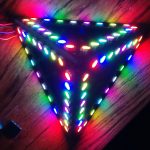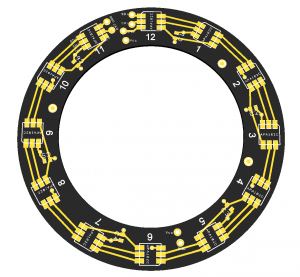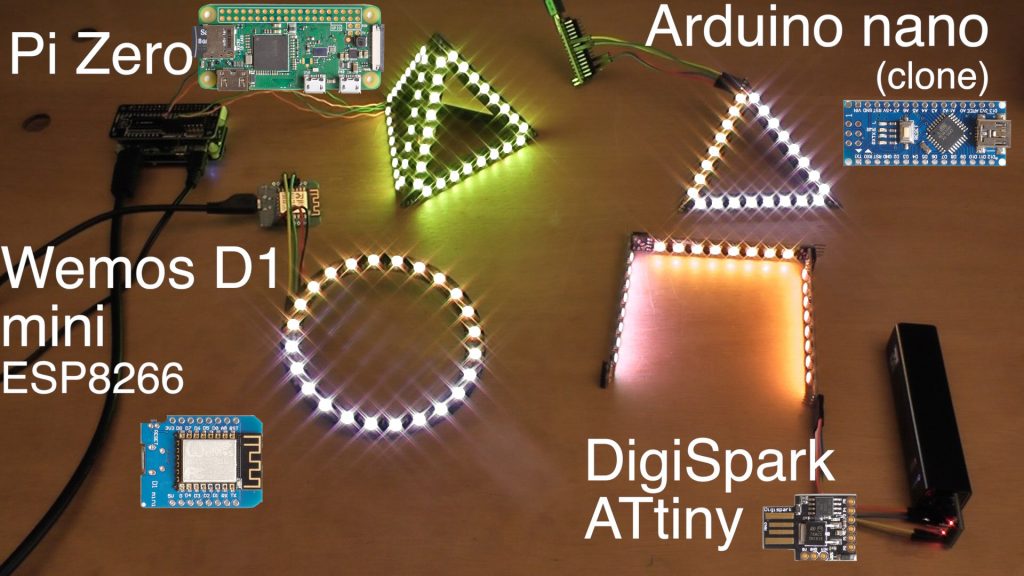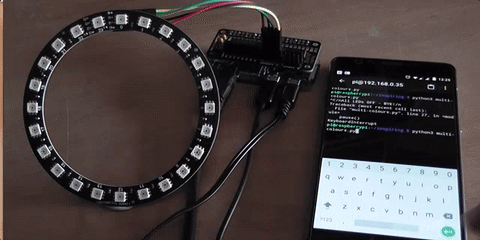
I’ve been playing with RGB LEDs on and off over the last year or so. They’re amazing things. It’s incredible to me that something so small can produce such bright and brilliantly coloured light.
I’ve played with the Adafruit DotStar Pi Painter project (using APA102), which is enormous fun. Also the Pimoroni MOTE (also APA102), which makes everything plug-and-play. Then there was the McRoboface from 4Tronix (using 2 sizes of WS2812). Then back in October 2016 I bought 4 quadrants of 15 WS2812 on ebay to make a 60-element clock.
And then one day, amidst all this ‘play’ in mid-December it struck me.
- Why has nobody done any shapes other than circles and straight lines?
- Why is there not a modular system allowing people to build their own shaped constructions – a bit like Lego, but for LEDs?
So I figured this would be a great idea for a RasPiO KickStarter project. Let’s see if the world wants this to happen? Here’s the KS video, but below it gives a run through of what had to happen to get to this stage…
We Need a Good Name
I considered (for a few nano-seconds) trying to trademark the name “LEDO”, but I think LEGO’s lawyers would have torn me to bits. Good name though. We’ll have to come up with something else.
So, being me, I decided to have a go. The first shape I designed (using my trusty DesignSpark PCB) was a small 12 LED ring of APA102c.
The plan was to run it from a Pi using Python. OK we need a name. I’ve made a Pi Ring. Several words end with “piring” let’s see what we’ve got…
- aspiring (quite liked that one)
- perspiring (EUW – just NO!)
- umpiring (nah)
- conspiring (nah)
- inspiring (YES YES YES – that’s the one!)
I loved inspiring because when you are inspired it’s like “the lights being switched on” in your head. And this is all about lights. So Inspiring it is then. I also quite like the idea of inspiring people to learn something about coding and hardware by being able to control their blinkies in an approachable way.
Let’s Get Them Made
So I got the ring and some straights prototyped. While I was waiting for those I designed a larger circle, triangle, square and semi-circle and managed to get all the prototype designs done in time for them to be shipped to me before China broke up for New Year.
I chose to use APA102c and ordered a bunch of those as well. They’re more expensive than WS2812, but they are a lot less fussy about timings and I wanted to be able to use SPI, which you can with these LEDs. It means we can use Python and hardware SPI on the Pi to control them.
So in the last week of December I received the first prototpyes, the LEDs, capacitors and stencils, built out some boards and tried them out. YAY – they worked. This gave me the confidence to design and order protos of the rest of the shapes.
By the end of January I had my Python software class written and prototypes of each shape made and tested. I’d also got them working with Arduino, Wemos D1 mini and DigiSpark boards, using the Arduino IDE and FastLED library.
I’d also managed to assemble a pyramid (well 3-sided – technically a pyramid has 4 triangular faces, but meh!) just in time for a scheduled visit to Pi Towers. Pretty much everyone who’s seen the pyramid has thought it pretty cool. If you’re going to the Pi Party at the week-end I’ll have it with me on the RasPiO stall. Come and have a look and say Hi!
Eben said he’d like to make a rhombicuboctahedron, which I remembered was the ‘ball’ shape you could make with a Rubik’s snake (35 years ago at school we used to have competitions – my record was 3 seconds from straight). Everyone liked the concept – even made some suggestions, which I’ve yet to fully process. I also got my hands on a Pi Zero W and managed to talk to Eben and Roger about it for my launch blog and video.
I think the Zero W is an awesome way to drive a RasPiO Inspiring NTP clock or pyramid – you could control it with your phone or through the internet. That’s why two of the KickStarter rewards include a Pi Zero W.
Where are we at now?
As I write this at 15:38 on day 1 of the Kickstarter, we’re just over 85% funded, which is fantastic. Thanks to all who have backed. If you haven’t backed (yet) please come and have a look at the KickStarter page and consider backing the project. It could turn into something really good if it does well enough to justify the time spent on the learning resources.
I don’t do Patreon or advertising on RasPi.TV. It is supported entirely by sales of RasPiO hardware. If you’d like to support RasPi.TV, I’d love you to back our hardware.



Looks like fun! Will probably back it after the PiParty :-)
Ignoring power-concerns, is there a limit to how many LEDs can be driven from a single driver board? Would it be possible to combine 4 triangles into a ‘full’ pyramid? Does the PiZero & driver phat fit ‘inside’ the circle? I guess a laser-cut acrylic mounting-frame would be a neat add-on for the clock kit.
Polyhedral fun https://en.wikipedia.org/wiki/Rhombicuboctahedron
From the signalling point of view you’re limited by the frame rate you want. SPI is fast enough to drive hundreds of these. From a practical point of view, with a frame rate of 30 fps, if you use Python you’re limited to a couple of hundred LEDs. But if you use something faster the limit is a lot lower. Yes you could do a 4 triangle pyramid (and even put a square on the bottom) but you’d need supplementary power if you wanted to drive it at full brightness. In reality, full brightness hurts your eyes to look at, so that’s why I say it’s not really needed in the KS pitch. Did I spell rhombicuboctahedron wrong? I missed off the H didn’t I? ;p
No I got it right – miracle LOL
Hah, by ‘full’ pyramid I actually meant using the 4th triangle to close off the bottom (i.e. a full tetrahedron) rather than making a square-based pyramid ;-)
Well done with your spelling – anyone would think you’ve been practising at improving your vocabulary…
Yes that would be possible too to make a tetrahedral pyramid
An Icosahedron has 20 triangular faces – that would light a whole room rather like a glitter globe! It might take a bit of current.
There appears to be a small problem with your videos. I’m running Windows 10 and I get only sound from the top video and neither sound nor pictures from the lower.
Sometimes clearing your browser’s cache fixes weird youtube problems.
I have ‘clear cache’ set every time I exit. Did a manual clear as well but videos still not working properly.
I used to make welded steel sculptures as a hobby. I’ve made both a rhombicuboctahedron and three stellated icosahedra of varying sizes. Took ages but they were lots of fun. I’ll see if I can dig up a photo